-

人教版新目标初中英语九年级下册By the time I got outside, the bus had already left教案
Ⅰ. Teaching Aims and Demands1. Knowledge Objects(1) Key Vocabularyoversleep(2) Target LanguageWhat happened?I overslept. And by the time I got up, my brother had already gotten in the shower.2. Ability Objects(1) Teach the students to use the new words.(2) Train the students to narrate past events with the Past Perfect Tense.(3) Train the students' listening and speaking skills with the target language.3. Moral ObjectIt’s a good habit to go to bed early in the evening and get up early in the morning. So you’ll never be in a hurry in the morning.Ⅱ. Teaching Key Points1. Key Vocabularyoversleep2. Target LanguageNarrate past events with the Past Perfect TenseⅢ. Teaching Difficult Points1. Train the students to narrate past events with the Past Perfect Tense.2. Train the students to understand the target language in spoken conversation.Ⅳ. Teaching Methods1. Thinking of examples from the students' real lives.2. Making sentences by looking at the pictures.Ⅴ. Teaching AidA tape recorderⅥ. Teaching ProceduresStep I Revision1. Revise the language points in Unit 8.Ask some questions like this: What volunteer work would you like to do?Help the students to answer, I’d like to…/I love to…/I hope to2. Practice the dialogue in Activity 3c on page 62 again. Get students to role play the similar dialogues with the following.

人教版新目标初中英语九年级上册It must belong to Carla教案
一、Section A该部分有4个模块。第一模块围绕Whose volleyball is this? 这一话题展开思维( 1a)、听力(1b)、口语( 1c)训练;第二模块围绕上一模块中的话题进行听力( 2a-2b)、口语训练( 2c);第三模块继续围绕前两个模块中的“making inferences”展开训练。训练形式为阅读排序( 3a)和两人问答(3b);第四模块仍就上一话题展开讨论。二、Section B该部分有4个模块。第一模块要求根据图画和所提供的单词写出合理的句子;第二模块在听力( 2a-2b)和分角色口语训练( 2c)的基础上,继续进行“推测”训练; 第三模块围绕“Strange events in Bell Tower neighborhood”这一话题展开阅读( 3a)和写作(3b -3c)训练;第四模块以dream为话题展开小组活动。三、Self Check该部分有3个模块。第一模块以填空形式对所学词汇进行训练;第二模块就8个谚语展开阅读和讨论。

人教版新目标初中英语九年级上册Where would you like to visit教案2篇
The First PeriodⅠ.Teaching Aims and DemandsKnowledge Objects(1) Key Vocabularytiring, educational, fascinating, thrilling, peaceful, exotic, trek, jungle, take it easy, explore, historic, site(2) Target LanguageWhere would you like to go on vacation?I’d like to trek through the jungle, because I like exciting vacations.2. Ability Objects(1)Train students to talk about places they would like to visit with the target language.(2)Train students to describe vacations with different adjectives.(3)Train students' listening skill.3. Moral Object,It′s more interesting to go on vacating somewhere instead of staying at home.Ⅱ. Teaching Key Points1. Key Vocabularytiring, educational, fascinating, thrilling, peaceful, exotic, trek, jungle, take it easy, explore, historic, site2. Target LanguageTalk about different places with the target language.Ⅲ. Teaching Difficult Points1. Describe vacations with different adjectives.2. Talk about different places with the target language.Ⅳ. Teaching Methods1. Teaching by illumination2. Teaching by doing chain drills3. Teaching by pairworkⅤ. Teaching Aids1. A tape recorder2. Some pictures of different places with famous views

人教版新目标初中英语九年级下册Rainy days make me sad教案
1. 教材分析本单元以how do things affect you?为话题, 从颜色、天气、音乐、广告、产品等方面谈论了外界事物如何影响人的心情。要求学生掌握表达某物或某事给人带来的感觉、看法或影响等。共设计了四个部分的内容:Section A 该部分有4个模块:第一模块围绕Which restaurant would you like to go to?这一话题展开思维(1a)、听力(1b)、口语(1c)训练;第二模块围绕How does music affect you? 进行听力(2a-2b)、口语训练(2c);第三模块继续围绕how do colors in the restaurant affect you这一话题展开训练,训练形式为阅读和问题体验(3a)和小组活动(3b);第四模块仍就How do things affect you这一话题以调查的形式展开讨论。Section B该部分有4个模块:第一模块围绕产品广告对人们的影响这一话题以“配对”(1a)与“列举”(1b)两种形式展开训练;第二模块继续围绕How do things affect you? 进行听力(2a-2b)、口语对话训练(2c);第三模块围绕“Advertising”这一话题展开阅读(3a-3b)和写作(3c)训练;第四模块围绕How posters affect you这一话题以口语训练形式展开小组活动。

人教版新目标初中英语九年级下册Could you please tell me where the restrooms are教案
Step Ⅰ RevisionCheck homework. Ask a few students to read the article in 3a.Then ask a few students to read their guides.Step Ⅱ Part 1Look at the words in the box. Ask a student to read them. Make sure the students understand the meaning of the words. You are to fill in the blanks with the words. In some cases, students may need to use another form of the word, for example adjusting for tense or subject/ verb agreement.Ask students to fill in the blanks on their own.Check the answers. Step ⅢPart 2Go through the instructions with the class.Look at the example with the students.Ask students what the answer would be.Ask a student to read the question and answer it.Excuse me, could you tell me where the bank is, please?The bank is across the street from the shopping malt.Get students to complete the work in pairs.Check the answers. Ask a few students to read their questions.Step Ⅳ Just for Fun!Ask all the students to read the conversation. Ask: What is funny about this cartoon? Help students to explain. A Martian is a person from the planet Mars.There is no such thing as Martian food on Earth, and the clerk looks silly because he is trying to think of where there is a Martian restaurant.Invite some pairs of students to present this conversation to the rest of the class.Step Ⅴ Summary and HomeworkIn this class, we’ve done much writing practice using the key vocabulary words and the target language presented in this unit. After class, please finish the questions in 2 in your exercise books. Then finish the exercises on pages 47~48 of the workbook as well.The Seventh Period Ⅰ Teaching Aims and Demands1. Knowledge Objects(1) Key Vocabularyimage, adventure, jealousy, hero, crime, journey, brave, no longer, show interest in, take it easy, become interested in, plain looks(2)Text:Grown-ups like cartoons, too.2. Ability Objects(1) Fast-reading to get a general idea of the text.(2) Careful-reading to get the detailed information in the text.

人教版新目标初中英语九年级下册I’ll help clean up the city parks教案
Talk about offering help (P60)I’ll help clean up the city parks.A: I’d like to work ...B: You could help ...Talk about ways to tell people about the Clean-Up Day (P61)We need to ...We can’t ...I’ll ...Talk about the work the volunteers do (P62)These three students all volunteer their time to help other people.Somebody loves to ... / helps ... / plans to ... / wants to ...A: What do you like doing?B: I like ... A: What kind of volunteer work do you think I could do?B: You could ...1. 重点词汇advertisement, fix, repair, pleasure, blind, deaf, shut, carry, specially, fetch2. 认读词汇hunger, homeless, cheer, clean-up, sign, establish, major, commitment, elementary, veterinarian, coach, similar, call-in, strategy, disabled, organization, unable, support, appreciate, donation, part of speech, pronoun, adverb, preposition, conjunction, donate, Jimmy, Sally3. 词组clean up, cheer up, give out, put off, set up, think up, take after, fix up, give away, put up, hand out, work out, at once

人教版新目标初中英语九年级下册We’re trying to save the manatees教案2篇
本单元主要围绕着有关濒临灭绝的动物这一话题,学习了应该怎样保护我们的环境,以及就某一问题展开辩论。目标提示语言目标能够运用所学知识,就某一问题展开辩论。认知目标1、复习一些语法:现在进行时、一般现在时、用used to 表示一般过去时、现在完成时、一般过去时的被动语态。2、学会表达同意和不同意。3、学会以下基本句型:We’re trying to save the manatees.Manatees eat about 100 pounds of food a day.There used to be a lot of manatees.In 1972,it was discovered that they were endangered.Some of the swamps have become polluted.情感目标了解一些濒临灭绝的动物的生活习性和濒临灭绝的原因,教育学生应该如何保护环境。教学提示充分利用多媒体等教学设备,创设与本课话题相关的情境,如各种不同种类的动物、动物园以及有关环境的画画等等。围绕着本单元的教学目标,设计一些贴近学生实际的教学任务,如让学生谈论自己最喜欢的动物,如何拯救濒危动物,如何保护环境等等。让学生根据所学知识,就动物园是否对动物有利以及其他的话题进行辩论。

人教版新目标初中英语九年级下册You’re supposed to shake hands教案
教学目标:1. 掌握本单元一些重点词汇的写法和用法。2. 学会自如谈论餐桌礼仪。Step 1 RevisionAsk some students to retell the customs at the table in France in the passage in 3a.Step 2 Self checkPart 1. Fill in each bland with the correct word given. Students do the exercises by themselves at first. Then check the answers. Ask the students to comprehend the sentences and help them point out uses of some words, like “arrive (at / in) sw., spend time / money on sth , spend time / money (in) doing sth.”Part 2. Read about Fan Ling’s experience in a western restaurant. Understand the passage. Point out some key points in the passage.1. be / get used to doing sth. 习惯做某事2. begin with = start with 以….开头3. crowd v. 挤满,塞满 the crowd 人群 crowded adj. 拥挤的Then students discuss about how she would solve her problem. Ask some to share their stories with others.Part 3. Complete the crossword by looking at the sentences on the left. Then check the answers.
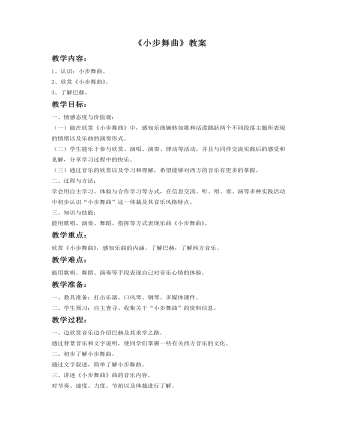
《小步舞曲教案》教案
教学过程:一、边欣赏音乐边介绍巴赫及其求学之路。通过背景音乐和文字说明,使同学们掌握一些有关西方音乐的文化。二、初步了解小步舞曲。通过文字叙述,简单了解小步舞曲。三、讲述《小步舞曲》曲的音乐内容。对节奏、速度、力度、节拍以及体裁进行了解。四、结合谱例分段学习《小步舞曲》。1、学习乐曲A’段。说明:依据乐曲创作背景,合理创设“舞会”情景,从而有效激发学生学习兴趣,用舞蹈表现手段演绎此乐段,发展了学生的舞蹈表演能力,享受到美的愉悦。2、学习乐曲B段。说明:利用形象、直观的图式辅助以及一系列贴近学生思维逻辑的问答讨论,激发学生的思考,帮助学生准确把握乐段情绪,并能用指挥、伴奏等方式表现该乐段。3、完整欣赏《小步舞曲》。说明:学生在完整欣赏乐曲时能够巩固乐曲主题的记忆,并且听辨、感受乐曲两个不同主题情绪,培养学生独立的音乐感受和见解。五、视频欣赏。说明:通过视屏欣赏,使同学们以一个更直观的郊区去理解和学习作品,并使同学对作品有更深刻的记忆。引起学生共鸣,领悟音乐的美感,愉悦身心,获取乐趣,从而激起学习的情趣。
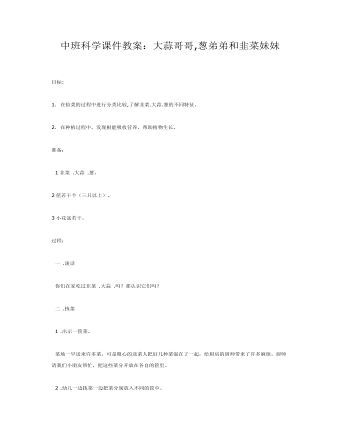
中班科学课件教案:大蒜哥哥,葱弟弟和韭菜妹妹
1. 在捡菜的过程中进行分类比较,了解韭菜.大蒜.葱的不同特征。2. 在种植过程中,发现根能吸收营养,帮助植物生长。准备: 1韭菜 .大蒜 .葱。2筐若干个(三只以上)。3小花盆若干。
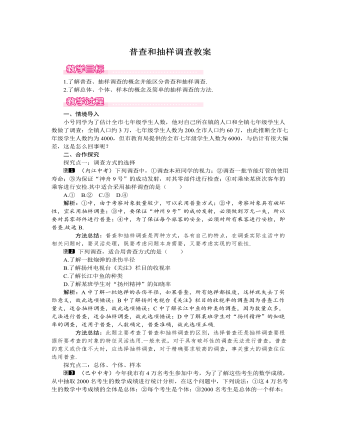
北师大初中七年级数学上册普查和抽样调查教案1
判断下面抽样调查选取样本的方法是否合适:(1)检查某啤酒厂即将出厂的啤酒质量情况,先随机抽取若干箱(捆),再在抽取的每箱(捆)中,随机抽取1~2瓶检查;(2)通过网上问卷调查方式,了解百姓对央视春节晚会的评价;(3)调查某市中小学生学习负担的状况,在该市每所小学的每个班级选取一名学生,进行问卷调查;(4)教育部为了调查中小学乱收费情况,调查了某市所有中小学生.解析:本题应看样本是否为简单随机样本,是否具有代表性.解:(1)合适,这是一种随机抽样的方法,样本为简单随机样本.(2)不合适,我国农村人口众多,多数农民是不上网的,所以调查的对象在总体中不具有代表性.(3)不合适,选取的样本中个体太少.(4)不合适,样本虽然足够大,但遗漏了其他城市里的这些群体,应在全国范围内分层选取样本,除了上述原因外,每班的学生全部作为样本是没有必要的.
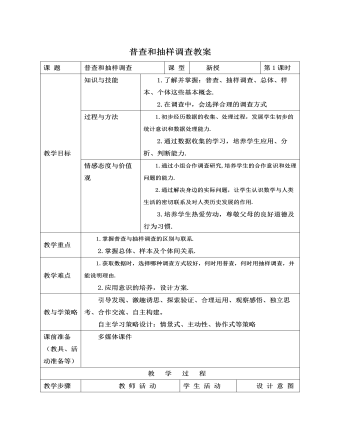
北师大初中七年级数学上册普查和抽样调查教案2
1.举例说明什么时候用普查的方式获得数据较好,什么时候用抽样调查的方式获得数据较好?2、下列调查中分别采用了那些调查方式?⑴为了了解你们班同学的身高,对全班同学进行调查.⑵为了了解你们学校学生对新教材的喜好情况,对所有学号是5的倍数的同学进行调查。3、说明在以下问题中,总体、个体、样本各指什么?⑴为了考察一个学校的学生参加课外体育活动的情况,调查了其中20名学生每天参加课外体育活动的时间.⑵为了了解一批电池的寿命,从中抽取10只进行实验。⑶为了考察某公园一年中每天进园的人数,在其中的30天里对进园的人数进行了统计。通过本节课的学习,同学们有什么收获和疑问?1、基本概念:⑴.调查、普查、抽样调查.⑵.总体、个体、样本.2、何时采用普查、何时采用抽样调查,各有什么优缺点?
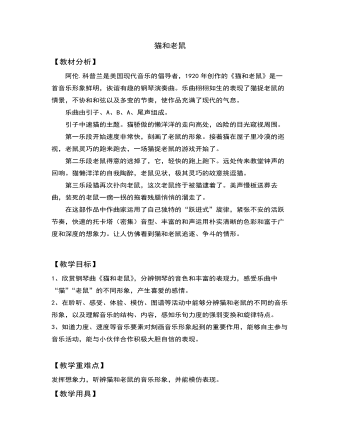
二年级音乐欣赏猫和老鼠教案教学设计
阿伦.科普兰是美国现代音乐的倡导者,1920年创作的《猫和老鼠》是一首音乐形象鲜明,诙谐有趣的钢琴演奏曲。乐曲栩栩如生的表现了猫捉老鼠的情景,不协和和弦以及多变的节奏,使作品充满了现代的气息。乐曲由引子、A、B、A、尾声组成。引子中速猫的主题。猫骄傲的懒洋洋的走向高处,凶险的目光窥视周围。第一乐段开始速度非常快,刻画了老鼠的形象。接着猫在屋子里冷漠的巡视,老鼠灵巧的跑来跑去,一场猫捉老鼠的游戏开始了。第二乐段老鼠得意的逃掉了,它,轻快的跑上跑下。远处传来教堂钟声的回响。猫懒洋洋的自我陶醉,老鼠见状,极其灵巧的故意挑逗猫。第三乐段猫再次扑向老鼠,这次老鼠终于被猫逮着了。美声慢板送葬去曲,装死的老鼠一瘸一拐的拖着残腿悄悄的溜走了。在这部作品中作曲家运用了自己独特的“跃进式”旋律,紧张不安的活跃节奏,快速的托卡塔(密集)音型、丰富的和声运用朴实清晰的色彩和富于广度和深度的想象力。让人仿佛看到猫和老鼠追逐、争斗的情形。
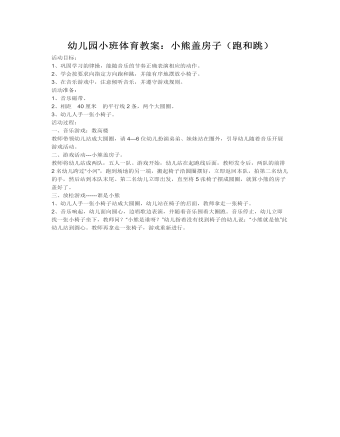
幼儿园小班体育教案:小熊盖房子(跑和跳)
2、学会按要求向指定方向跑和跳,并能有序地摆放小椅子。 3、在音乐游戏中,注意倾听音乐,并遵守游戏规则。 活动准备: 1、音乐磁带、 2、相距 40厘米 的平行线2条,两个大圆圈。 3、幼儿人手一张小椅子。 活动过程: 一、音乐游戏:数高楼 教师带领幼儿站成大圆圈,请4—6位幼儿扮演弟弟、妹妹站在圈外,引导幼儿随着音乐开展游戏活动。

大班科学课件教案:常绿树和落叶树
2、发展分析、比较能力,激发幼儿观察大自然变化的兴趣。准备:课前教幼儿认识一些常见的树叶。收集一些树叶。过程:一、初步形成常绿树、落叶树的概念。每组一篮树叶,小朋友观察比较。这些是什么树叶?比一比,他们有什么不同?
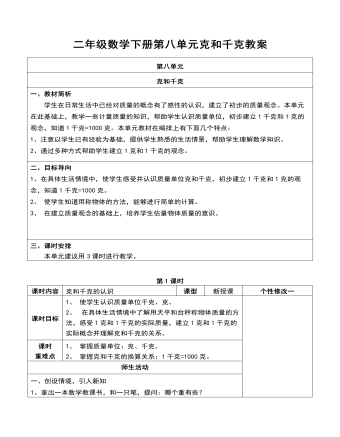
二年级数学下册第八单元克和千克教案
1、拿出一本数学教课书,和一只笔,提问:哪个重有些?2、肯定学生的回答,并让学生“掂一掂”,然后让学生说说有什么样的感觉。3、从刚才的实践得出结论:物体有轻有重。板书课题。二、观察、操作领悟新知1、出示主题挂图,物体的轻重的计量。观察主题挂图。(1、)请同学们观察一下,这幅图画的是什么?(2、)这幅图中的小朋友和阿姨在说什么?(3、)前几天,老师让大家广泛收集、调查我们日常生活中常见物品的质量,我们现在来交流以下好吗?表示物品有多重,可以用克和千克单位来表示。(4、)在学生说的同时,老师拿出有准备的东西展示。
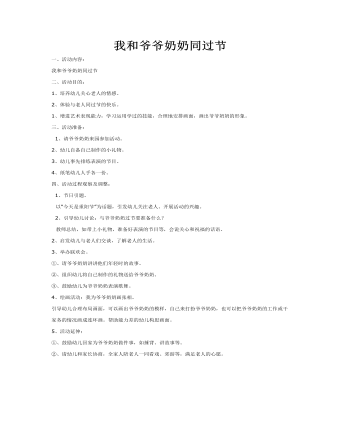
大班社会教案:我和爷爷奶奶同过节(重阳)
二、活动目的: 1、培养幼儿关心老人的情感。 2、体验与老人同过节的快乐。 1、增进艺术表现能力,学习运用学过的技能,合理地安排画面,画出爷爷奶奶的形象。 三、活动准备: 1、请爷爷奶奶来园参加活动。 2、幼儿自备自己制作的小礼物。 3、幼儿事先排练表演的节目。 4、纸笔幼儿人手各一份。
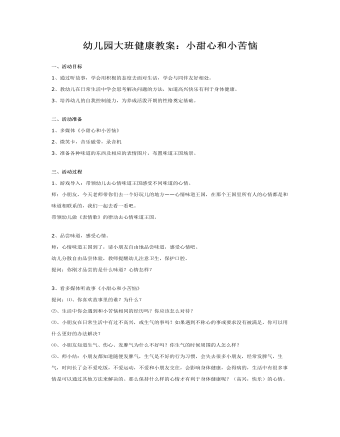
幼儿园大班健康教案:小甜心和小苦恼
二、活动准备 1、多媒体《小甜心和小苦恼》 2、微笑卡,音乐磁带,录音机 3、准备各种味道的东西及相应的表情图片,布置味道王国场景。三、活动过程 1、游戏导入:带领幼儿去心情味道王国感受不同味道的心情。 师:小朋友,今天老师带你们去一个好玩儿的地方——心情味道王国,在那个王国里所有人的心情都是和味道相联系的,我们一起去看一看吧。 带领幼儿做《表情歌》的律动去心情味道王国。2、品尝味道,感受心情。 师:心情味道王国到了,请小朋友自由地品尝味道,感受心情吧。 幼儿分散自由品尝体验,教师提醒幼儿注意卫生,保护口腔。 提问:你刚才品尝的是什么味道?心情怎样?
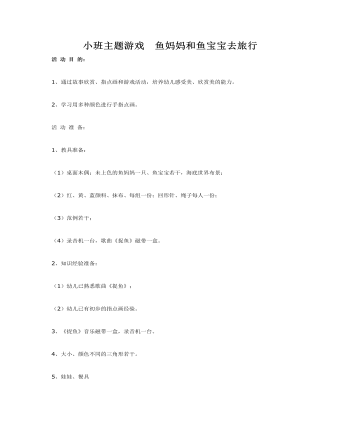
小班主题游戏 鱼妈妈和鱼宝宝去旅行课件教案
2、学习用多种颜色进行手指点画。活动准备:1、教具准备:(1)桌面木偶:未上色的鱼妈妈一只、鱼宝宝若干,海底世界布景;(2)红、黄、蓝颜料、抹布、每组一份;回形针、绳子每人一份;(3)范例若干;(4)录音机一台,歌曲《捉鱼》磁带一盒。2、知识经验准备:(1)幼儿已熟悉歌曲《捉鱼》;(2)幼儿已有初步的指点画经验。
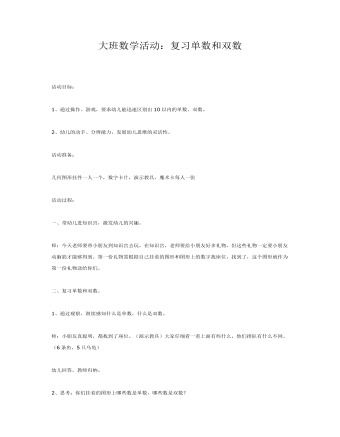
大班数学活动:复习单数和双数课件教案
2、幼儿的动手、分辨能力,发展幼儿思维的灵活性。活动准备:几何图形挂件一人一个,数字卡片,演示教具,魔术卡每人一张活动过程:一、带幼儿进知识宫,激发幼儿的兴趣。师:今天老师要带小朋友到知识宫去玩。在知识宫,老师要给小朋友好多礼物,但这些礼物一定要小朋友动脑筋才能够得到。第一份礼物需根据自己挂着的图形和图形上的数字找座位,找到了,这个图形就作为第一份礼物送给你们。